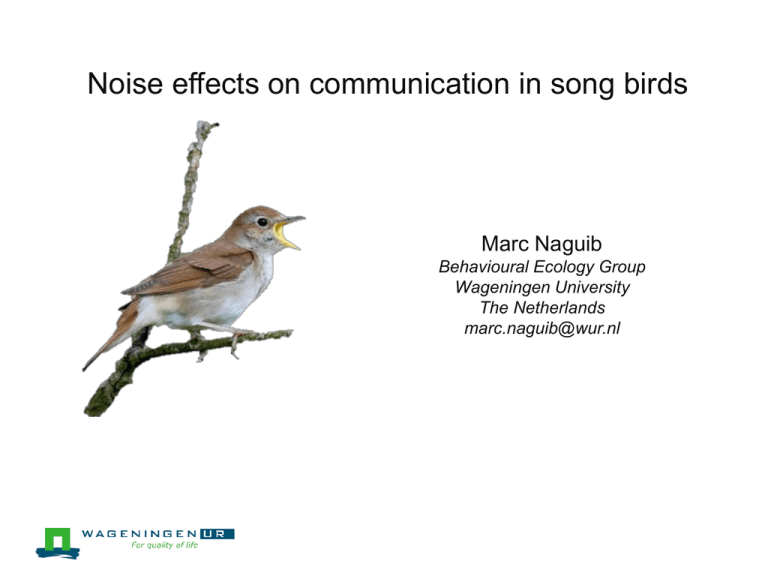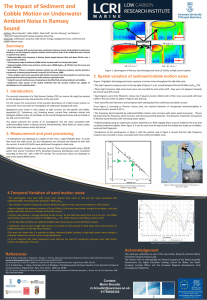Slides
advertisement

Noise effects on communication in song birds Marc Naguib Behavioural Ecology Group Wageningen University The Netherlands marc.naguib@wur.nl Effects of noise depend on • Signal structure • Signal function • Spatial characteristics • Noise characteristics • Individual traits Environmental constraints on communication Sound transmission characteristics Environmental noise The main adaptations of birdsong to long range communication Birds in denser habitats use lower frequencies than birds in open habitats Birds in dense habitats use slower trills than birds in open habitats. (Morton 1975, Sorjonen 1986, Wiley 1991) Grasshopper warbler kHz 10 Song element repetition rates 8 6 4 2 0.5 1 1.5 2 s Open habitats Yellow hammer kHz Grasshopper warbler Yellow hammer 10 8 6 10 ms 10 ms 4 2 0.5 1 1.5 2 s Chaffinch kHz 7 6 5 4 3 2 1 0.5 kHz 10 1 1.5 2 2.5 Wren 3 3.5 s Woods Chaffinch Wren 90 ms 70 ms 5 2s (also see Wiley 1991, Naguib 2003) Sound degradation as distance cues Carolina wren Distance cues • Reverberation • High frequency content • Relative amplitude Naguib 1995, 1996, 1997 Signal structure and communication distance Broad bandwidth lower frequency Amplitude Amplitude Narrow bandwidth higher frequency 1 lower frequency higher frequency 1 2 2 distance distance 1: JND for excess attenuation 2: JND for distance difference (after Naguib and Wiley, Anim Behav 2001) (after Brumm and Naguib, Adv. Study Behav 2009) Noise constrains detection of: information coded in signal distance related changes Effects on time budgets and spacing Urban birds change their tune City birds sing at higher frequencies than rural birds Slabbekoorn and Peet, Nature 2003 Nightingales sing louder with increasing noise levels Brumm and Todt 2002 Indirect effects of noise on communication From Naguib 2013 Indirect effects of noise on communication • • • • Gene regulation Heart rate Immune response Blood pressure • Fearfulness • Attention • Learning • Habitat choice • Spatial behaviour Do negative effects of noise result from masking or from disturbance? Do negative effects of noise result from masking or from disturbance? 1. Disturb and mask frequency 2. Disturb only time 3. Control: empty box with no playback Noise characteristics or animal characteristics (personality) Field population of great tits (Parus major) kHz 20 1V Personality test (novel environment) kHz 20 (a) Noise playbacks during parental care period kHz 20 (b) 15 15 15 10 10 10 5 5 5 5s 1V 5s 1V (c) 5s 2h playback of 60 randomly timed 1 min noise bouts Noise Silence Begging activity (min with calls) Control Disturb only Disturb and mask Before During After Playback period (Naguib et al 2013, Anim Behav) Control Begging activity (minutes with begging calls) Chicks beg more when parents visit Disturb only Chicks beg less during noise Mask-and-disturb Kind of noise does not matter except when parents are absent absent present (Naguib et al 2013, Anim Behav) Latency to first visit in noise Disturb only Disturb and mask Exploration score (Naguib et al 2013, Anim Behav) Relative number of visits in noise Sexes respond in opposite ways to noise, depending on personality 0.6 Males 0.4 0.2 Females 0 0 slow 20 40 Exploration score 60 fast (Naguib et al 2013, Anim Behav) Conclusion • Signals evolved to reduce degradation • Signal degradation as distance cues • Noise can affect communication also indirectly, without masking a signal • Response to noise can be personality-dependent Thanks to: Joe Waas, Kees van Oers, Waikato University, New Zealand Netherlands Institute of Ecology The Royal Dutch Academy for Arts and Sciences Do negative effects of noise result from masking or from disturbance? Percent songs, call, or song switches in noise vocalizations MaleMale vocalizations 100 DO DM * † 90 80 Disturb only Disturb and mask 70 60 50 40 30 20 10 0 songs in in noise Songs noise callsininnoise noise Calls switchesin noise Songsong switches











